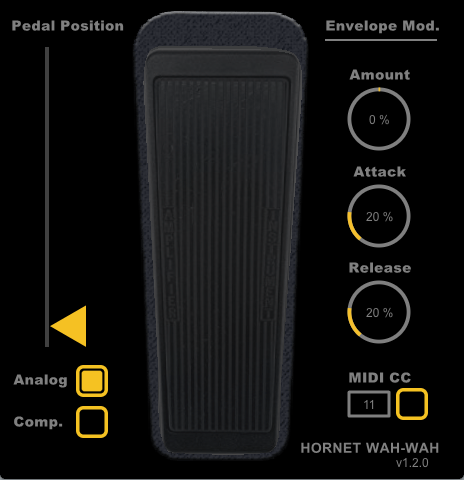|
🎃 HoRNet plugins up to 75% off with code HALLOWEEN2025 for the next |
Feature update for the advanced volume automation tool
We have just released an important update for two of our most useful and popular plugins: TrackUtility MK2 and HoRNet WahWah. These updates bring essential improvements, including Apple Silicon native support, improved performance, and cleaner integration with modern systems. Whether you’re a professional sound engineer, music producer, or casual creator, these tools offer incredible flexibility, helping you save time and work more efficiently.
TrackUtility MK2 is often referred to as the Swiss army knife of audio tools, and for good reason. It includes a variety of essential processors in a single interface. Tasks that would typically require several different plugins are now managed by one compact, easy-to-use solution. It’s perfect for quick fixes, simple routing changes, and basic mastering moves. You can use it for DC offset removal, mono/stereo conversion, panning, gain trimming, and more. Thanks to its lightweight design, you can leave it on-screen alongside other tools without it getting in the way.
A key strength of TrackUtility MK2 is how seamlessly it integrates into any workflow. For everyday production needs, this plugin becomes a reliable go-to tool. Need to collapse a stereo track to mono? Remove unwanted DC from a vocal recording? Quickly adjust the volume or pan of a signal without opening a full-featured channel strip? TrackUtility MK2 handles it all, fast and efficiently.
In addition to its utility functions, TrackUtility MK2 also includes tools for quick mastering on the master bus. The built-in limiter, auto gain, and stereo wideness control (which also serves as a fake stereo simulator) make it ideal for final-stage adjustments. You can easily dial in your desired RMS level, engage auto gain, activate the limiter, and shape your stereo image. This simple process makes it a powerful tool for fast mastering when time or resources are limited.
With the latest version, TrackUtility MK2 introduces several new features. One of the most significant is the grouping function, which allows you to control multiple plugin instances simultaneously. This is particularly useful when working with buses or groups of tracks, such as background vocals or layered instruments, where you need to apply consistent adjustments across several channels at once.
We’ve also updated the RMS meter, which now includes a freely adjustable window. This gives you more precise visual feedback when managing dynamics, allowing you to fine-tune loudness with better accuracy. Additionally, the plugin now features the latest auto-gain algorithm, improving the way it adapts signal levels without introducing artifacts. The limiter has also been enhanced, incorporating the same high-performance algorithm used in Magnus, and offering three different auto-release time settings to tailor dynamics more precisely.
Now let’s turn to the HoRNet WahWah, a digital recreation of a legendary vintage wah pedal from the 1970s. Designed to capture the soulful and funky essence of the original hardware, HoRNet WahWah offers that classic expressive tone known from countless guitar and keyboard performances. This plugin is not only faithful to the original pedal’s character but also expands on it with modern features to give musicians and producers even more creative control.
At the core of HoRNet WahWah is its traditional sweeping filter, producing that iconic “wah” sound when modulated. We’ve included an envelope follower, which allows the plugin to respond dynamically to your input signal. You can independently adjust the attack and release times of the envelope, allowing for extremely expressive and varied responses. The modulation is based on the current pedal position, letting you create a full range of tones, from a dark, throaty “woh” to a piercing, bright “wah”.
You can also control the intensity of the modulation using the modulation depth setting, which ranges from subtle to extreme. This lets you use HoRNet WahWah in many contexts, from traditional guitar solos to experimental electronic tracks. Like many of our plugins, it also includes an option to disable analog saturation. The saturation is generated by an internal transistor amplifier modeled after the original pedal’s circuitry. If you’re looking for a clean signal, turning it off gives you that option. However, the saturation is part of what gives the wah effect its charm and character, and we recommend experimenting with it to find your preferred tone.
With this update, HoRNet WahWah also receives Apple Silicon native support, making it fully compatible with the latest Mac hardware. This means smoother performance, lower latency, and better resource efficiency when running on Apple’s M-series processors. Additionally, we’ve raised the minimum supported macOS version to 10.11, and removed 32-bit support for Windows. These changes allow us to focus on modern systems and deliver the best possible experience for current operating systems and hardware configurations.
Both plugins—TrackUtility MK2 and HoRNet WahWah—are now more powerful, more stable, and better suited for the modern production environment. Whether you’re editing, mixing, mastering, or just shaping a creative idea, these tools are designed to help you get results fast.
The update is free for existing owners and can be downloaded via the HoRNet DoIn installer or directly from the user area on our website. We recommend all users update to the latest versions to take full advantage of the performance improvements and new features introduced in version 2.1.0 for WahWah and version 1.3.0 for TrackUtility MK2.
In summary, these updates reflect our ongoing commitment to keeping our tools aligned with current production standards. We understand how important it is to have plugins that are fast, reliable, and compatible with modern workflows. With native Apple Silicon support, enhanced features, and a refined user experience, TrackUtility MK2 and HoRNet WahWah continue to be essential additions to any audio professional’s toolkit.
